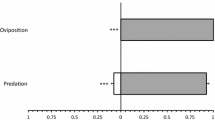Abstract
The presence of spines on woody plants has been shown to limit the loss of foliage to large mammalian browsers by restricting both bite size and biting rate. We tested the hypothesis that plant spines are also an effective defense against browsing by small mammals, such as rodents, that climb within the canopy of shrubs to harvest fruits, seeds, and foliage. Tame southern plains woodrats (Neotoma micropus) were allowed to harvest raisins impaled on the branches of blackbrush shrubs (Acacia rigidula Benth.) in five categories of spinescence: naturally spineless, moderately spiny, or very spiny branches, and moderately spiny and very spiny branches with the spines removed. Plant spinescence significantly reduced the woodrats foraging efficiency (P = 0.0001). Although plant spines are generally thought to be an evolved defense against browsing by ungulate herbivores, they may also reduce browsing by small mammals.
Similar content being viewed by others
Author information
Authors and Affiliations
Additional information
Received: 15 May 1997 / Accepted: 29 August 1997
Rights and permissions
About this article
Cite this article
Cooper, S., Ginnett, T. Spines protect plants against browsing by small climbing mammals. Oecologia 113, 219–221 (1998). https://doi.org/10.1007/s004420050371
Issue Date:
DOI: https://doi.org/10.1007/s004420050371




